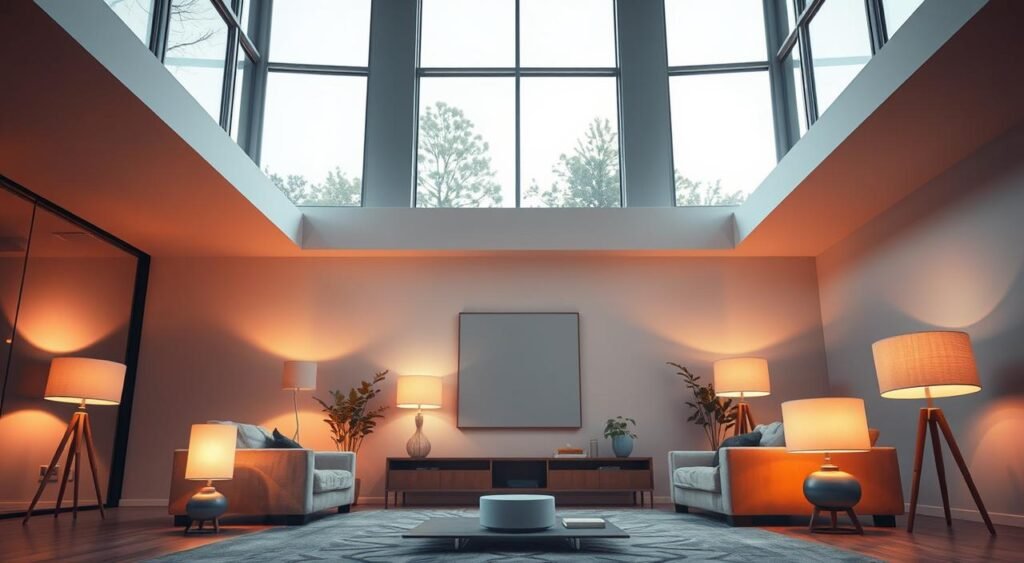Imagine this: You’re cozy in bed, but the living room light is blazing. Why scramble out of bed when your voice could turn it off? Welcome to the world of voice-controlled lighting systems—where flicking switches becomes a thing of the past. Tired of juggling remotes or apps? Smart home devices like Lutron’s Caséta Wireless let you command your lights with phrases as simple as “Alexa, dim the kitchen.”
Picture this: A system that learns your habits, dims lights for movie nights, or even syncs with your security system. Sound futuristic? It’s already here. With setups as easy as saying “Hey Google, goodnight,” why settle for outdated switches? This article shows you how to upgrade without breaking the bank—whether you’re a tech pro or just starting out.
Key Takeaways
- Control lights hands-free using voice commands like “turn off the dining room.”
- Lutron’s Caséta Wireless works with Alexa for seamless voice setups.
- Create movie-night scenes or energy-saving routines in minutes via apps.
- Systems like Casambi support up to 20 custom voice commands for personalized control.
- Get started today with budget-friendly options that grow with your smart home.
The Evolution of Home Lighting: From Switches to Voice Commands
Imagine a time when turning on lights meant fumbling for a switch in the dark. Or, worse, leaving them on by accident. Those days are behind us. Today, smart lighting and home automation have transformed our homes.
The Traditional Lighting Limitations
Old lighting setups required manual adjustments for each light. No dimming or scheduling was possible. This led to wasted energy, as lights stayed on in unoccupied rooms. The era of change had begun.
The Smart Lighting Revolution
Systems like Philips Hue and LIFX introduced a new era. You could control lights through apps or timers. Yet, it needed screens and buttons. The leap to home automation brought:
- Remote control via smartphones
- Automated schedules to save energy
- Color customization for mood-setting
How Voice Control Changed Everything
Voice commands ushered in a new level of convenience. With Amazon Alexa, you can say, “Alexa, dim the kitchen lights to 50%.” This innovation offers:
| Hands-free convenience | Control lights without lifting a finger |
|---|---|
| Accessibility | Empowers users with mobility challenges |
| Seamless integration | Works with thermostats, security, and more |
“Voice control made our home feel alive,” says the Smith family, who cut energy bills by 30% using voice-activated routines.
By 2024, these systems will understand even more complex commands. They will blend smart lighting with AI. Are you ready to bid farewell to switches? Let’s explore how voice commands work next.
What Exactly Is a Voice Controlled Lighting System?
Imagine flipping a switch just by speaking—or dimming lights with a whisper. That’s the magic of a voice controlled lighting system! It combines smart bulbs, voice assistants like Alexa or Google Home, and Wi-Fi or Bluetooth. This turns your home into a responsive space. Let’s break it down:
- Smart bulbs or fixtures: These are the “ears and brains” of your lighting.
- Voice assistants: Think of them as your home’s friendly helper, waiting for your commands.
- Connectivity: Wi-Fi or Bluetooth bridges the gap between your voice and the lights.
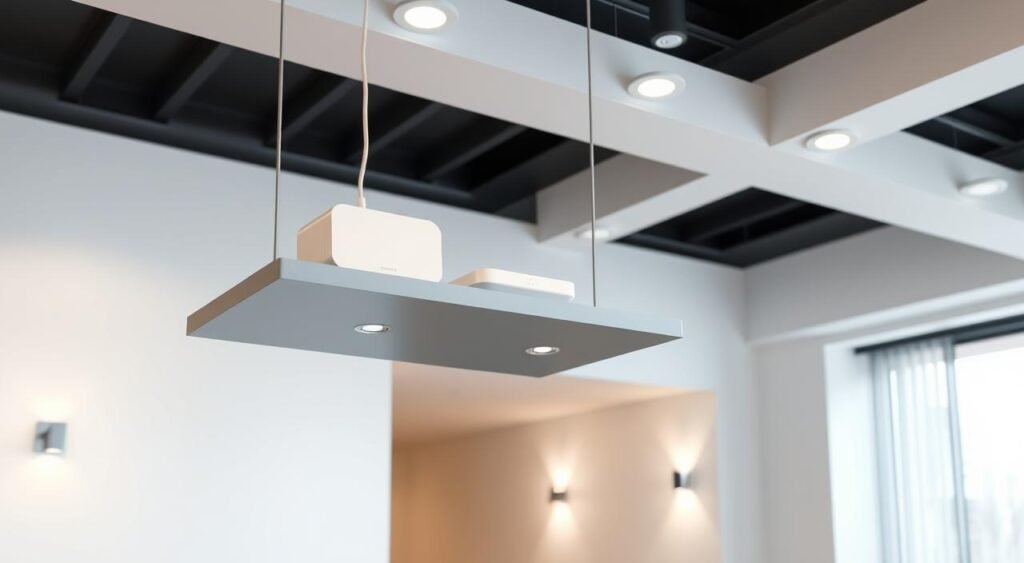
Here’s how it works: You say, “Hey Google, dim the living room to 50%,” and voice activation technology translates your words into action. Want movie night? Say the phrase, and lights dim instantly. Need brighter kitchen lights? Just ask! Systems like Willow even let you set aliases—like “dining” instead of “dining_room_lights”—to simplify commands.
Think of it as your home learning your language. Whether it’s “Good Night mode” that turns off all lights or overriding a smart thermostat’s schedule, the system adapts to you. Ready to ditch switches and embrace hands-free living? Your home’s lighting is about to get a whole lot smarter.
Key Benefits of Voice Activated Lighting in Your Home
Imagine walking in with groceries or holding a baby while saying, “Hey Google, turn on the kitchen lights!” Voice activation technology transforms daily life, making smart lighting a staple in modern homes. Over a quarter of U.S. adults already rely on smart speakers, and this number keeps growing. Let’s explore how voice-controlled lighting becomes your home’s ultimate sidekick.
72% of smart speaker owners use them daily—proof that voice control isn’t a gimmick but a practical tool.
Convenience and Accessibility
- Hands-free control lets you manage lights while cooking, cleaning, or relaxing.
- Perfect for seniors or those with mobility challenges—adjust brightness or colors with a simple phrase.
- No more scrambling for switches in the dark! Just say “Lights on!” and enjoy instant illumination.
Energy Efficiency and Cost Savings
Smart lighting paired with voice commands cuts energy waste. Set routines like “Goodnight” to dim lights automatically at bedtime. Studies show users slash electricity bills by 15-25% with this tech.
Enhanced Home Security
Use voice activation technology to simulate occupancy when you’re away. Tell Alexa to “Activate vacation mode,” and lights flicker like you’re home. Pair with security cameras for a full safety shield.
Creating the Perfect Ambiance Instantly
Whether it’s a cozy movie night (“Set mood mode to cinema”) or a vibrant dinner party (“Boost the kitchen lights to 80%”), smart lighting responds instantly. Philips Hue and LIFX systems let you pick from thousands of colors via voice—no apps needed.
Ready to turn your home into a space that listens and adapts? Voice-activated smart lighting isn’t just tech—it’s a lifestyle upgrade anyone can enjoy.
How Voice Recognition Technology Works With Smart Lighting
Let’s explore the magic behind voice activation technology in wireless lighting systems. Picture this: you say, “Hey Google, dim the dining room lights.” Here’s what unfolds:
- Wake Word Detection: Your device waits for a trigger phrase like “Alexa” or “Okay Google.” Microphone arrays with DSP chips focus on your voice, cutting through noise—even in a bustling kitchen.
- Speech to Text: Once activated, the system uses Automatic Speech Recognition (ASR) to translate your words into a digital command. It’s like a translator for your home’s language!
- Action Execution: The command then goes to your wireless lighting systems, adjusting brightness, colors, or schedules. For instance, saying “Goodnight mode” might dim lights and set a sunset hue.
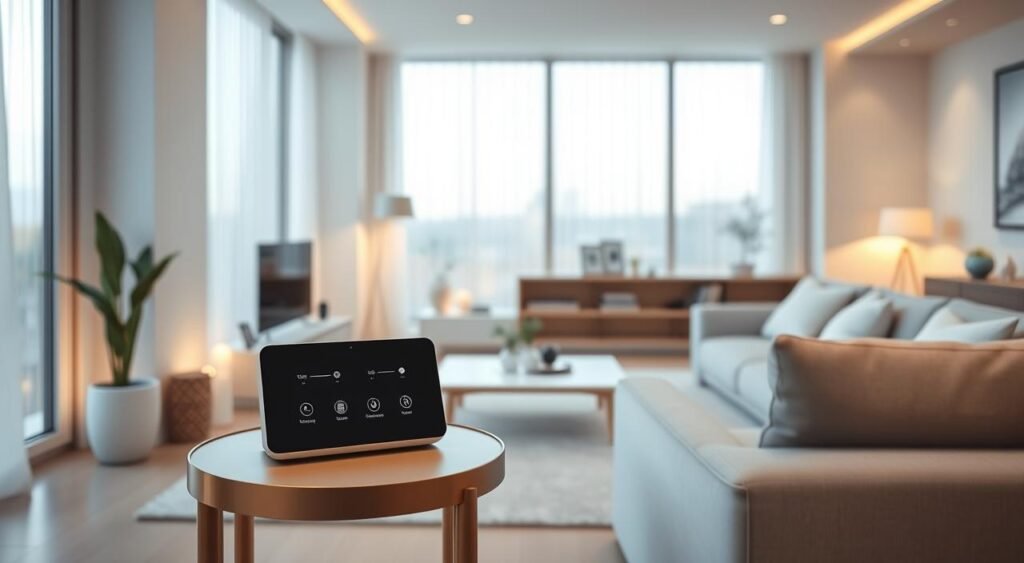
Privacy is key! Many systems process commands locally (like Snips’ open-source platform) to safeguard data. Plus, language models now grasp context—ask for “movie night lighting” and your system knows to dim lights and sync with your TV setup.
“The real game-changer is how these systems learn your habits,” says a leading smart home developer. “They adapt to your voice over time, becoming almost intuitive.”
Ready to say goodbye to switches? With voice activation technology, even complex routines—like syncing dawn-to-dawn lighting with sunrise times—become effortless. Your home’s wireless lighting systems now listen, learn, and respond—all without lifting a finger.
Popular Voice Assistants for Controlling Your Lights
Choosing the right voice assistant is akin to selecting your home’s new best friend. It’s someone who understands your style and quirks. Let’s explore the top options to help you find the perfect fit for your smart home.
“Alexa’s simplicity and budget-friendly options make it a favorite for first-time smart home users.”
Now, let’s examine what each platform offers:
Amazon Alexa Integration
- Works with Philips Hue, LIFX, and countless others
- Supports routines like “Alexa, dim the dining lights to 50%”
- Best for users already in the Amazon ecosystem
Google Assistant Capabilities
- Recognizes natural phrases like “Get party-ready!” to activate color schemes
- Syncs with Nest Hub displays and Chromecast
- Perfect for households with Android devices
Apple HomeKit and Siri
- Exclusive features like secure Face ID-protected lighting scenes
- Seamlessly links iPhones, iPads, and Apple Watches
- I recommend this to Apple loyalists craving privacy-first control
Other Voice Assistant Options
Josh.ai is notable for its discreet microphones that don’t interrupt your music while taking commands. Samsung Bixby integrates with Galaxy devices, while Microsoft Cortana works smoothly with Windows PCs. Even niche brands like Samsung SmartThings offer unique voice control for their smart home devices.
Regardless of your choice, these assistants transform your home into a responsive space. Saying “lights on” feels like magic—without the tech headaches.
Essential Components of a Voice Controlled Lighting System
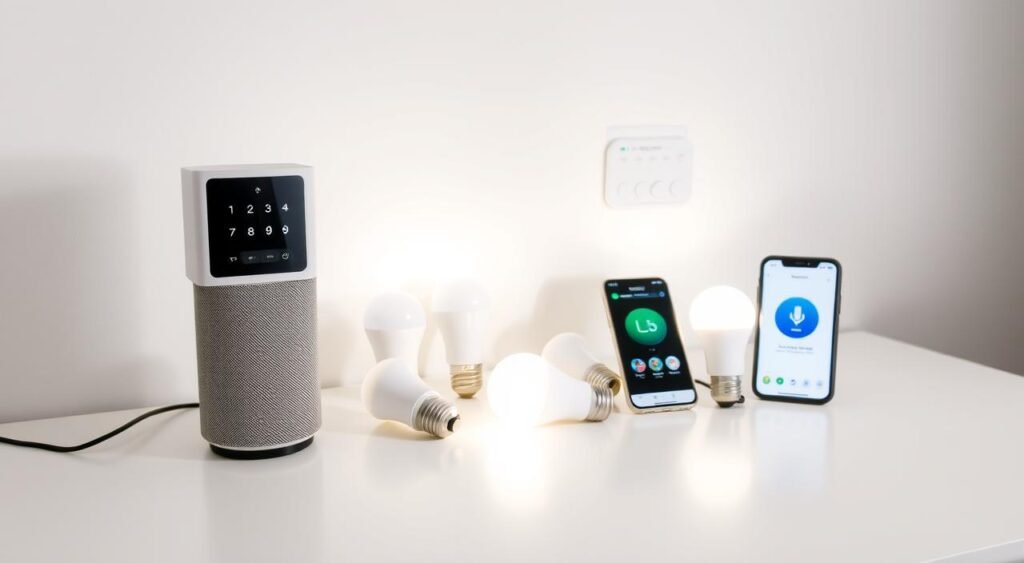
Exploring the components of a voice controlled lighting system is straightforward. No need for complex tech terms. It’s all about the three main parts that make it work:
- 1. The Brain: Voice Assistant Hub
Every voice controlled lighting system has a central hub. This could be an Amazon Echo with Alexa, Google Home, or an Arduino Uno with a DFRobot DFPlayer Mini module. These hubs interpret your voice commands and control the lights. - 2. The Lights: Smart Bulbs or Switches
Choose bulbs like Philips Hue or LIFX that connect to your hub. For older fixtures, opt for Wi-Fi enabled smart switches like the TP-Link Kasa. Wireless lighting systems like IKEA Tradfri use Zigbee for efficient, mesh network reliability. - 3. The Connection: Network Infrastructure
A robust Wi-Fi network is essential. Zigbee or Z-Wave protocols are ideal for multi-room setups. Even simple Arduino setups require a Bluetooth module like HC-05 for phone connectivity.
| Component | Description | Price Range |
|---|---|---|
| Microcontroller (Arduino Uno) | Processes commands & controls circuits | $20–$30 |
| Wireless Modules | DFRobot DFPlayer Mini, HC-05 Bluetooth | $10–$25 |
| Lighting Hardware | Philips Hue bulbs, LIFX, or IKEA Tradfri | $15–$100+ |
| Power Supply | 12V DC adapter (Arduino setups) | $5–$15 |
Starting small is a great approach. Begin with a $30 Arduino Uno + DFRobot module combo. Expand your setup with more bulbs or switches as needed. The wireless lighting systems market is modular, allowing you to grow your setup gradually.
Setting Up Your First Voice Controlled Smart Lights
Ready to transform your home into a voice-activated wonderland? We’ll guide you through setting up your first voice controlled devices and smart lighting system. It’s easier than you think.
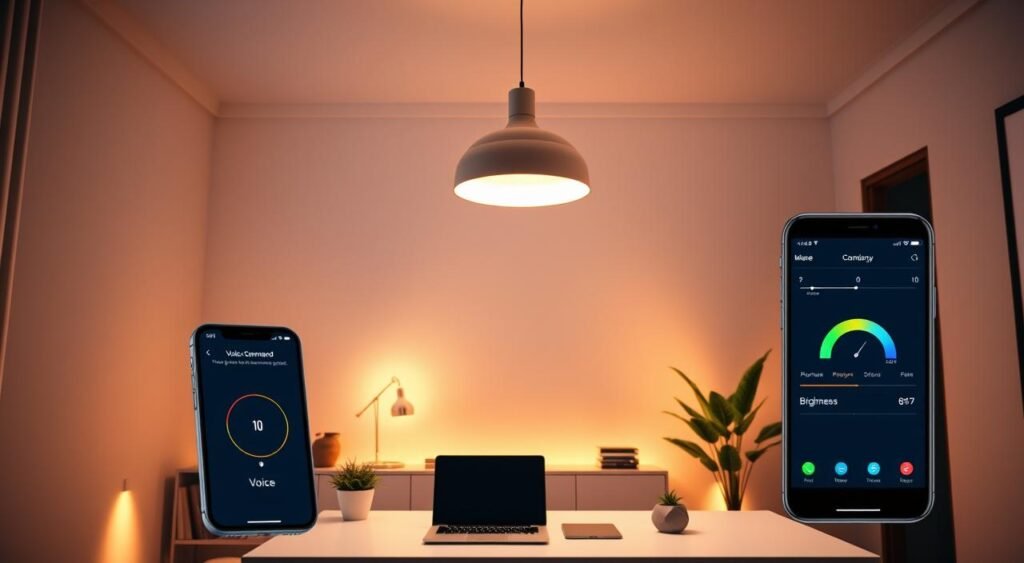
Choosing Compatible Bulbs and Fixtures
Begin by selecting bulbs that are compatible with your voice assistant. Brands like Philips Hue, LIFX, or TP-Link Kasa are known to work seamlessly with Alexa, Google Assistant, or Siri. Ensure your fixtures are compatible with screw-in bulbs or switches for full control.
Hub vs. Hub-Free Systems
Some systems, like Philips Hue, require a hub for network connection. Others, such as LIFX or Google Nest, are hub-free, perfect for a minimalist setup. Consider your needs: do you prefer simplicity or a fully integrated system?
Network Requirements and Considerations
“Strong Wi-Fi is your best friend for lag-free control.”
Ensure your Wi-Fi speed is at least 20 Mbps for smooth control. Place bulbs or hubs in areas with strong signal strength. If using Zigbee or Z-Wave, confirm your hub supports these protocols.
Step-by-Step Installation Guide
- Download the brand’s app (Philips Hue, LIFX, etc.) and create an account.
- Screw in bulbs or install switches, then power them on.
- Follow the app’s prompts to name lights and assign rooms.
- Link your voice assistant—say, “Alexa, discover devices” or “Hey Google, find my lights.”
- Test commands like, “Hey Google, dim the kitchen to 50%!”
Having trouble? Check your Wi-Fi or try resetting the bulb. Remember, you can start with just 2-3 bulbs and expand as you become more comfortable.
Beyond Basic Commands: Advanced Voice Control Features
Did you know your voice controlled lighting system can do way more than on/off? Let’s explore features that transform your home into a responsive space that understands your every word! With voice activation technology, you’re not just flipping switches—you’re orchestrating a symphony of light.
“Siri, goodnight!” That’s all it takes to turn off lights, lock doors, and set the thermostat. Now that’s smart living!
Imagine saying, “Dim the kitchen lights to 30%” or “Set the living room to sunset mode.” Advanced systems allow you to adjust color, brightness, and even sync lights to music or movies. Here’s how it works:
- Color & Brightness Tweaks: Use phrases like “Make the dining room amber” for cozy dinners or “Full brightness in the garage” for projects.
- Scene Automation: Create routines like “Movie night mode” that dims lights, lowers blinds, and dims TVs with a single command.
- Conditional Commands: Say “Turn on porch lights after sunset” or “Activate away mode when I leave” for security and energy savings.
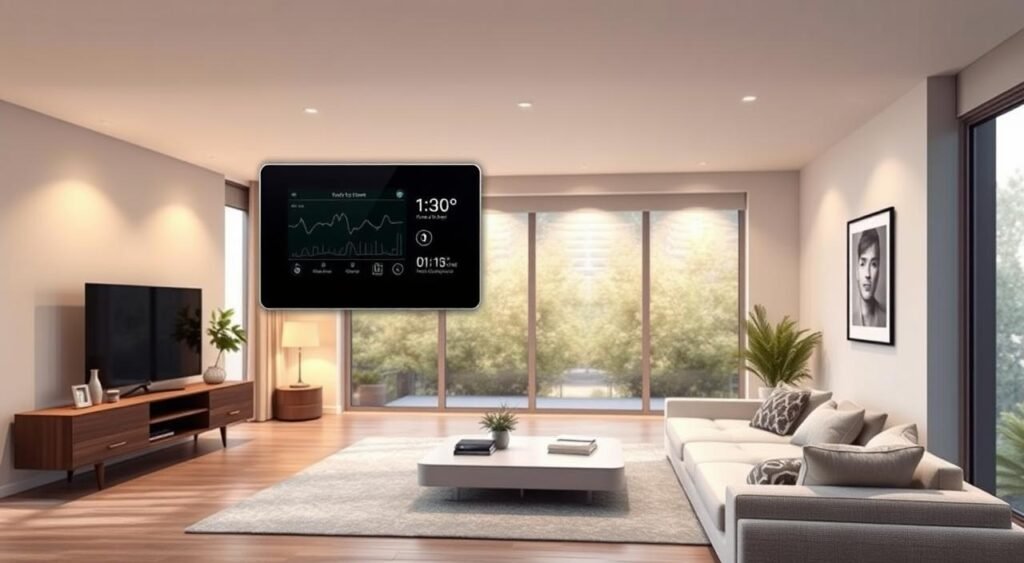
| Command Type | Example Command | Result |
|---|---|---|
| Scene Activation | “Alexa, start movie night” | Dim lights, lower shades, and mute notifications |
| Conditional Logic | “If it rains, turn on patio lights” | Lights activate when weather sensors detect rain |
| Multi-Device Commands | “Hey Google, bedtime routine” | Lights dim, thermostat lowers, and blinds close |
These features aren’t just futuristic—they’re practical. Whether you’re hosting a party or just want hands-free cooking, your system adapts to you. Ready to level up? Let’s talk about how to craft routines that fit your lifestyle!
Creating Custom Lighting Scenes and Routines
Imagine waking up to a gentle sunrise simulation or dimming your living room lights with a simple voice command. Smart lighting and home automation enable you to craft moments that reflect your lifestyle. Systems like Josh.ai make this easy with natural voice commands—like “Evening mode” or “Movie night”—that adjust lights, blinds, and even thermostat settings. Let’s explore how to create these personalized scenes today!
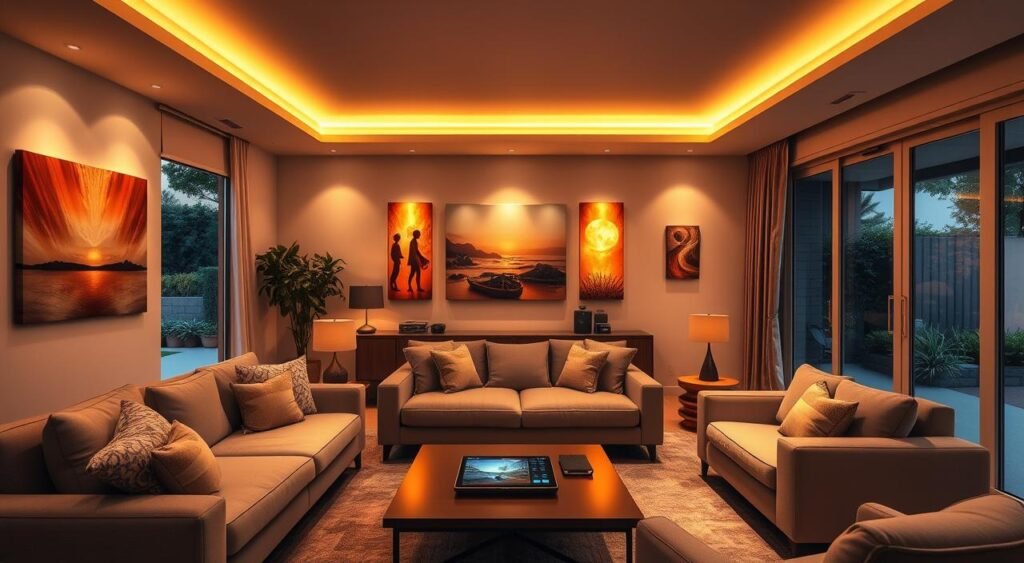
Morning and Evening Routines
Begin your day with a morning routine that turns on kitchen lights at 7 a.m. and warms up bathroom lights for your shower. Evening routines can dim living room lamps to 30% at sunset, then switch to nightlight modes after 10 p.m. Use phrases like “Good morning” or “Bedtime” to trigger these settings. Josh.ai even learns your habits, adjusting scenes based on time or location—like dimming lights when you say, “I’m reading.”
Entertainment and Party Modes
Hosting a dinner? Activate a “Dinner Party” scene with warm dining room lights and under-cabinet kitchen lighting. For movie nights, say, “Movie mode,” and your system will dim overhead lights, spotlight the TV, and sync with your soundbar. Create custom scenes like “Game Night” or “Holiday Glow” using your app—adjust brightness, color, and even add music cues for full immersion.
Vacation and Security Settings
Protect your home with vacation scenes that randomize porch, living room, and hallway lights. Combine them with security cameras for a layered defense. Say, “Activate away mode,” and lights will flicker on/off while your system arms alarms. Josh.ai’s privacy-first design ensures your routines stay secure, never storing voice data without your consent.
Integrating Voice Controlled Lighting With Other Smart Home Devices
Imagine saying “Hey Google, movie night!” and your lights dim, the TV turns on, and the room cools. This is the power of connecting voice controlled devices with your smart home. Let’s dive into how lighting becomes the central piece of your connected home.
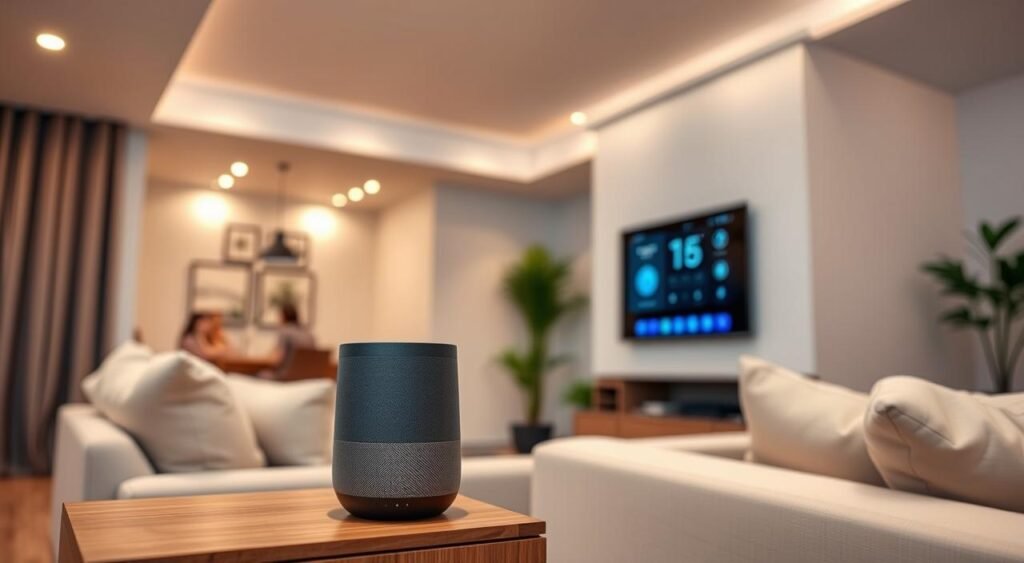
First, smart home devices like Nest thermostats and Ring doorbells work well with voice systems. For instance, pair Philips Hue lights with Alexa. Say “Alexa, make it cozy” and your AC drops to 70° and your lamps warm up. No need to switch apps—just one command does everything.
- Climate Control: Link Lutron Caseta lights with Ecobee thermostats for automated comfort zones.
- Security Synergy: Nest cameras trigger Arlo lights to flash when motion’s detected, scaring off intruders.
- Entertainment Sync: Samsung TVs and Sengled bulbs adjust together—say “Play movie mode” and lights dim as the screen brightens.
Pro tip: Always check compatibility charts. Brands like Apple HomeKit and Philips require MFi certification for flawless voice commands. Need help? Start small—add one new device monthly. Soon, your home will feel like a tech showcase without breaking the bank. The future isn’t just here—it’s as simple as speaking up.
Troubleshooting Common Voice Controlled Lighting Issues
Sometimes, your voice controlled lighting system might malfunction. But, most issues are easily resolved. Here’s how to fix your smart lights without needing tech support:

- Commands Ignored? Ensure your Echo Dot or Google Nest is close. If commands are muffled, clean the grille and test in a quiet space. Say “Alexa, what’s your name?” to check if it’s working.
- Lights Flickering or Lagging? Restart your router and bulbs. Check for firmware updates in the app—outdated software is common. For wireless lighting systems, make sure Bluetooth or Wi-Fi signals aren’t blocked by walls.
- Groups Not Working? Confirm all bulbs are in the same network group. Use simple names like “dining room” instead of long ones. Try specific commands like “Hey Google, turn on kitchen lights” instead of vague ones.
Stuck? Here’s a secret tip:
- Reset bulbs by holding their on/off button for 20 seconds (check manuals for specifics)
- Use a mesh network extender if your home has Wi-Fi dead zones
- Pair new devices one at a time to avoid setup conflicts
Even the best systems need occasional maintenance. Stick to the same ecosystem, like Amazon’s Alexa devices, to avoid compatibility issues. And remember: “If all else fails, unplug and reboot!”—a universal fix for 90% of tech problems. You’ve got this!
Best Voice Controlled Lighting Systems for Different Budgets
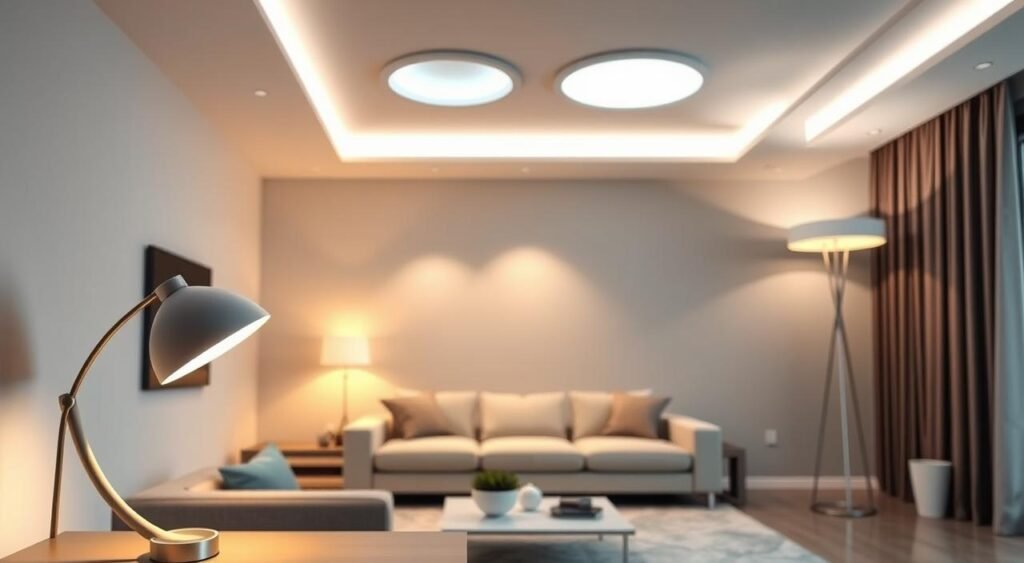
Upgrading your home’s lighting doesn’t have to break the bank. Here’s your guide to voice-controlled devices that fit any budget—without sacrificing style or convenience.
Entry-Level Options Under $100
Start small with these picks that prove affordable doesn’t mean basic:
- Govee Wi-Fi LED Bulb ($20): 16 million colors, no hub needed. Works with Alexa/Google—perfect for a single room.
- Ring Pathlight Solar ($30: Solar-powered outdoor lights with motion sensors. Voice control via Alexa or Ring app.
- Nanoleaf Matter Essentials ($190: Future-proof with Matter tech. Bright panels for walls or ceilings—ideal for budget-conscious DIYers.
Mid-Range Systems ($100-$300)
Step up to color-changing and automation without maxing your budget:
- Lutron Caseta Dimmer ($100: Sleek in-wall switches for smooth dimming. Works with all major voice assistants.
- Nanoleaf Shapes 4D ($190: Mirror TV visuals onto walls. Sync with music or movies via voice commands.
- Philips Hue White & Color Ambiance ($200: High-quality bulbs with precise color control. Pair with a hub for full system control.
Premium Whole-Home Solutions ($300+)
For those craving luxury and total control, these systems redefine smart lighting:
- Josh.ai Custom Install ($500+: Privacy-first tech—no data sold! Built-in mic kill switch and local servers. The blockquote goes here:
Josh.ai never shares your data—your commands stays in your home.
- Lutron Caseta Wireless Pro ($300: Professional-grade dimming with seamless voice control. Ideal for large homes.
- Philips Hue Play Lightstrip Pro ($250: Sleek LED strips for under-cabinet or accent lighting. Voice control for instant ambiance.
Whatever your budget, these picks prove smart lighting is accessible. Voice-controlled devices today are smarter, cheaper, and more secure than ever. Ready to light up your space? Start exploring what fits your style—and your price tag.
Future Trends in Voice Activated Lighting Technology
Imagine lights that adjust to your habits without you doing a thing. The future of voice activation technology and home automation promises to change how we interact with light. Let’s explore what’s coming.
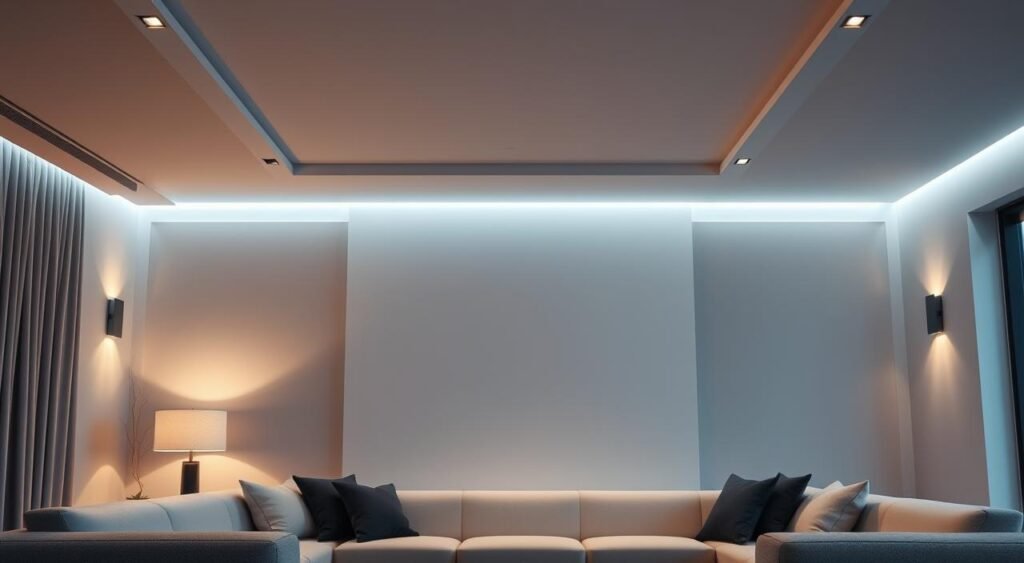
- Smarter AI Learning: Systems will use AI to memorize your routines—like dimming lights when you relax or brightening for morning workouts.
- Personalized Voice Recognition: Distinguish between family members’ voices to tailor settings. Say “bedtime” and your room adapts to your unique preferences.
- Green Energy Sync: Lights powered by solar or kinetic energy will pair with voice commands for eco-friendly control.
- Seamless IoT Expansion: Voice commands will manage not just lights but thermostats, blinds, and even window shades in one smooth system.
| Trend | How It Works |
|---|---|
| Predictive Adjustments | Lights anticipate your needs via motion sensors and AI analysis |
| Gesture + Voice Hybrid | Combine voice commands with wave-of-the-hand controls for effortless adjustments |
| Privacy-First Design | Local data processing reduces security risks while maintaining voice command accuracy |
Companies like Philips Hue and LIFX are already testing these features. Soon, they’ll be the norm. With voice activation technology getting smarter, even complex requests like “set movie mode” will trigger dimmed lights, closed shades, and paused smart speakers automatically. Get ready for lighting that feels like magic, without the tech overwhelm!
Conclusion: Transforming Your Home With the Power of Voice
Imagine walking into a home where the lighting adjusts instantly with a simple voice command. Voice-controlled lighting systems are not just futuristic; they’re here to make life easier. They blend convenience with efficiency, allowing you to control lights without lifting a finger and reducing energy consumption. It’s like your home is learning your habits, adapting to your needs.
Smart home devices, such as voice-activated lighting, are more than just trends; they’re smart investments. They save money by optimizing energy use through AI, as shown in proven energy-saving strategies. Whether adjusting brightness while cooking or ensuring safety with automated routines, voice control adapts to your lifestyle. Systems like Amazon Alexa or Google Assistant now understand natural language, making interactions effortless.
Start small with a starter kit and expand as you discover new features. Imagine your living room lighting up at sunset without you lifting a finger, or your hallway lights guiding you safely at night. These moments add up to a home that truly feels like yours. With AI-driven systems learning your preferences daily, every voice command brings you closer to a space that works smarter, not harder.
Don’t wait for tomorrow’s tech—embrace it today. Your journey begins with a single phrase: “Okay Google, let’s start.” The future of home life isn’t just voice-controlled—it’s personalized, efficient, and ready to transform ordinary routines into something extraordinary. Your smart home awaits—what will you say next?
FAQ
What is a voice-controlled lighting system?
A voice-controlled lighting system lets you manage your lights with voice commands. This is done through a voice assistant like Amazon Alexa or Google Assistant. It uses smart bulbs or fixtures that connect wirelessly to your home network.
How do I set up a voice-controlled lighting system?
Setting up a voice-controlled lighting system is straightforward. You need a voice assistant, compatible smart bulbs or fixtures, and a stable Wi-Fi network. Install the smart bulbs, connect them to your voice assistant, and start controlling your lights with voice commands.
Can I use voice control to create lighting scenes?
Yes, you can! Create custom lighting scenes for different activities, like movie nights or dinner parties. Group lights and set specific colors and brightness levels through your voice assistant.
Are voice-controlled lighting systems energy-efficient?
Yes, they are! Voice-controlled lighting systems can save energy. They let you manage your lights better, like turning them off when not in use or setting schedules. This can lower your electricity bills.
What if my voice commands are not recognized?
If your voice commands aren’t recognized, check the microphone placement of your voice assistant. Ensure your wake word is clear and minimize background noise for better accuracy.
Do voice-controlled lighting systems work with other smart home devices?
Yes! Many voice-controlled lighting systems integrate well with other smart home devices. This includes thermostats, security cameras, and entertainment systems. It creates a smart home ecosystem that enhances convenience and security.
What platforms support voice-controlled lighting?
Popular platforms for voice-controlled lighting include Amazon Alexa, Google Assistant, and Apple HomeKit/Siri. Each offers various compatible smart lighting brands and unique features.
Can I control the brightness and color of my smart lights with voice commands?
Yes! Adjusting brightness levels and changing the color of your smart lights is easy with voice commands. This adds to the versatility of your lighting experience.
How secure is my data with voice-controlled lighting systems?
Security measures differ by brand, but most reputable systems prioritize user privacy. They often provide options for local processing to safeguard your data.
